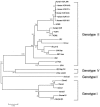Identification of novel human hepatitis E virus (HEV) isolates and determination of the seroprevalence of HEV in Korea
- PMID: 16000413
- PMCID: PMC1169173
- DOI: 10.1128/JCM.43.7.3042-3048.2005
Identification of novel human hepatitis E virus (HEV) isolates and determination of the seroprevalence of HEV in Korea
Abstract
Hepatitis E virus (HEV) was originally identified as the causative agent of enterically transmitted non-A, non-B hepatitis. Recently, HEV isolates were subsequently identified in humans and swine in many countries, including Korea. Also, public concerns regarding HEV as a potential zoonotic agent have been increasing. Therefore, we attempted to identify HEV from Korean sera and compare the nucleotide sequences with those of previously identified HEV isolates from other countries. In our study, viral RNA was purified from 568 human sera collected from different regions of Korea. Nested PCR and reverse transcriptase PCR were developed based on the nucleotide sequences of open reading frame 2 (ORF 2) of U.S. and Japanese HEV isolates from humans and Korean HEV isolates from swine. After amplification of the HEV ORF 2 gene from 14 serum samples that were collected mainly from rural areas (2.64% prevalence of HEV viremia), the gene was cloned and sequenced. The isolates were classified into seven different strains, all of which belonged to genotype III. The human isolates we identified were closely related to three Korean swine isolates, with 99.2 to 92.9% nucleotide sequence homology. Our isolates were also related to the Japanese and U.S. HEV isolates, with 99.6 to 97.9% amino acid sequence homology. Human sera were collected from 361 individuals from community health centers and medical colleges. With respect to seroprevalence, 11.9% of the Korean population had anti-HEV immunoglobulin G (IgG). In individuals ranging in age from 40 to over 60 years, the prevalence of anti-HEV IgG was demonstrated by a seroprevalence of almost 15%, especially among populations in rural areas. This is the first report on the identification of human HEV in Korea. Overall, this study demonstrates that subclinical HEV infections may prevail in human populations in Korea and that there is a strong possibility that HEV is a zoonotic agent.
Figures


References
-
- Arankalle, V. A., M. K. Goverdhan, and K. Banerjee. 1994. Antibodies against hepatitis E virus in Old World monkeys. J. Viral Hepat. 1:125-129. - PubMed
-
- Arankalle, V. A., M. V. Joshi, A. M. Kulkarni, S. S. Gandhe, L. P. Chobe, S. S. Rautmare, A. C. Mishra, and V. S. Padbidri. 2001. Prevalence of anti-hepatitis E virus antibodies in different Indian animal species. J. Viral Hepat. 8:223-227. - PubMed
-
- Arankalle, V. A., S. Paranjape, S. U. Emerson, R. H. Purcell, and A. M. Walimbe. 1999. Phylogenetic analysis of hepatitis E virus isolates from India (1976-1993). J. Gen. Virol. 80:1691-1700. - PubMed
-
- Balayan, M. S., A. G. Andjaparidze, S. S. Savinskaya, E. S. Ketiladze, D. M. Braginsky, A. P. Savinov, and V. F. Poleschuk. 1983. Evidence for a virus in non-A, non-B hepatitis transmitted via the fecal-oral route. Intervirology 20:23-31. - PubMed
Publication types
MeSH terms
Substances
Associated data
- Actions
- Actions
- Actions
- Actions
- Actions
- Actions
- Actions
LinkOut - more resources
Full Text Sources

